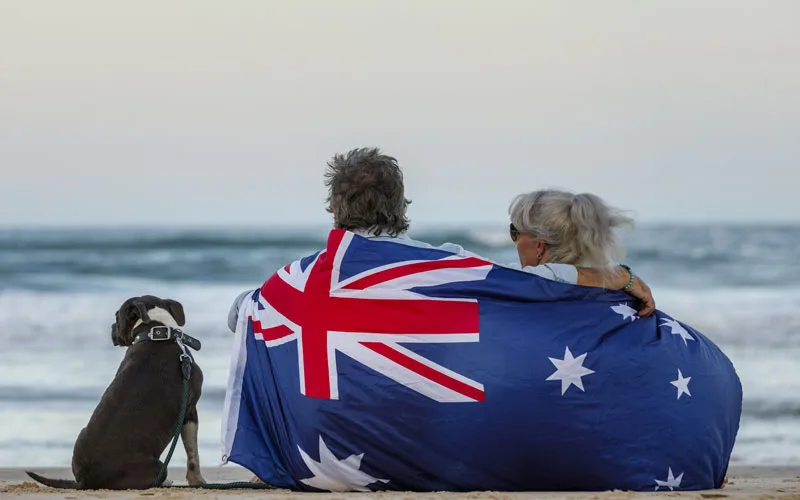On This Page...
ToggleIntroduction: Why This Guide Exists
After decades of helping thousands of couples apply for partner visas — across every relationship type, background, and visa complication — I’ve learned one hard truth: most people don’t fully understand what they’re walking into. And that’s not their fault. The process is complex, the stakes are high, and the rules aren’t always clear. But getting it wrong can cost more than just time and money. It can cost your future together.
This guide is for couples who are trying to stay together in Australia through the de facto partner visa process. Whether you’re same-sex or opposite-sex, married or unmarried, living together or long distance — this is your roadmap. It’s written in plain English and built on more than 25 years of experience advising on real cases, in real-life situations.
We’ll cover the key questions you probably already have — and more importantly, I’ll answer the ones you didn’t even know to ask.
I want this to be the most accurate, up-to-date, and useful guide available. So if you come across anything in this article that needs clarification or updating, please reach out. It won’t just help me — it will help our whole community of applicants, lawyers, agents and partners working toward better immigration outcomes.
Because when we get the information right, we give people their future back.
Section 1: Understanding the Partner Visa Framework
The Australian partner visa program is designed to keep couples together where one person is an Australian citizen, permanent resident, or eligible New Zealand citizen, and the other is not.
There are two main processing pathways:
A. Onshore Partner Visa – Subclass 820/801
This is for couples who are both in Australia.
- You apply while you’re in Australia
- You usually get a Bridging Visa while your application is processed
- After two years, you may be eligible for permanent residency via subclass 801
B. Offshore Partner Visa – Subclass 309/100
This is for couples applying from outside Australia.
- The applicant must be outside Australia at the time of application
- They receive subclass 309 (temporary) first
- After two years, you may be eligible for permanent residency via subclass 100 (permanent)
Both streams involve a two-stage process, and both require a significant amount of evidence, time, and patience.
Section 2: What “De Facto” Really Means in Australian Migration Law
The word “de facto” gets thrown around a lot, but in immigration law, it has a specific meaning — and simply living together isn’t enough.
You’re in a de facto relationship if:
- You are not married to each other
- You are not related by family
- You live together (or have lived together) on a genuine domestic basis
- You are in a mutual commitment to a shared life, to the exclusion of all others
Many couples assume sharing a house equals de facto. Not necessarily. If you’re just flatmates, or there’s no financial or emotional interdependence, you won’t qualify.
On the other hand, some couples who don’t live together full-time — due to FIFO work, military service, or other reasons — may still meet the definition if they can show a shared life in other ways.
The relationship must also be genuine and continuing at the time of application. This is critical. If you’re separated at the time of lodgement, or if the relationship isn’t real (on paper or in life), your application is likely to fail — and no amount of appeal strategy can undo that.
Section 3: The 12-Month Rule and Relationship Registration Workaround
To apply as a de facto partner, you usually need to show that:
- You’ve lived together for at least 12 months, and
- That cohabitation occurred immediately before lodging your application.
But there’s a workaround — and it’s a very strategic one.
If you register your relationship with an Australian state or territory that has a formal relationship register, you can skip the 12-month cohabitation requirement.
This is especially useful for:
- Long-distance couples
- Couples who’ve only recently moved in together
- Couples whose living situation makes cohabitation impractical
Section 4: Where Can You Register Your Relationship?
Here’s how the states and territories stack up:
✅ Relationship Registration Available:
- New South Wales
- Victoria
- Queensland
- South Australia
- Tasmania
- Australian Capital Territory
These states allow both same-sex and opposite-sex couples to register a relationship, even if they haven’t lived together for a full 12 months.
Registration usually takes 28 days (after a cooling-off period) and requires proof of identity and residence in that state.
❌ Registration Not Available:
- Western Australia
- Northern Territory
If you live in WA or NT and don’t have 12 months of cohabitation, you may be forced to wait — or move interstate temporarily.
Section 5: Same-Sex Couples and the Impact of Marriage
Since December 2017, same-sex marriage has been legal in Australia. That means same-sex couples who are married enjoy the same rights as opposite-sex couples when applying for a partner visa.
If you are married, you do not need to prove 12 months of cohabitation. The marriage itself satisfies the relationship requirement — but only if it’s recognised under Australian law.
If you were married overseas, and the country where you married also recognises same-sex marriage, then your marriage is likely to be recognised here.
However, you still need to prove that your relationship is genuine and continuing — marriage is not a shortcut. The Department will still assess the financial, social, household, and commitment aspects of your relationship.
Section 6: Can You Apply Onshore?
Yes — but only if your current visa doesn’t have restrictions.
The onshore partner visa (820/801) is available only if:
- You are physically in Australia
- You hold a visa that allows you to make a further application
- Your visa does not have Condition 8503 – No Further Stay
Many visitors arrive on a subclass 600 tourist visa. Some of those visas come with 8503, which prevents you from lodging another substantive visa while in Australia.
If that’s you, your options are limited:
- You can apply for a waiver of 8503 — but it’s not guaranteed
- Or you’ll have to leave Australia and apply from offshore (309/100)
Section 7: What Happens After Lodging Onshore?
Once you lodge a valid onshore application:
- You’ll receive a Bridging Visa A (BVA)
- That visa activates when your current visa expires
- You’ll be able to stay lawfully in Australia
- You’ll usually be granted full work rights
- You’ll be eligible for Medicare
A key point: work rights only start when the bridging visa becomes active — not while you’re still on a visitor visa. If your visitor visa lasts three months, you may have to wait that long before you can work.
If you need to travel overseas while waiting for your application to be processed, you must apply for a Bridging Visa B (BVB) before leaving — or you risk not being able to return.
Section 8: What the Department Wants to See — And What They Don’t
The Department of Home Affairs doesn’t care about how much you love each other. It cares about how well you can prove you live like a couple.
Your application will be assessed across four broad categories:
1. Financial Aspects
You need to show financial interdependence. This might include:
- A joint bank account that you both actually use
- Shared rent or mortgage payments
- Joint bills
- Car loans, insurance, or other liabilities in both names
A “sleeping” joint account with no real activity won’t help. They want to see real financial blending.
2. Household Aspects
The question here is: are you living together as a couple or just sharing a space?
- Mail going to the same address
- Joint household responsibilities (cleaning, cooking, planning)
- Lease agreements, tenancy contracts
Declarations from others (via Form 888) are useful, but your own statements — well-written and detailed — often make or break the application.
3. Social Aspects
Do your friends and family know you’re together?
- Photos at social events
- Wedding invites (as a couple)
- Holidays or trips
- Statements from people close to you
Be careful with social media — too much can look performative, too little can raise eyebrows. Be real.
4. Nature of the Commitment
This is the most subjective part, but the most powerful when done well.
- Your plans for the future
- How you support each other emotionally and practically
- Whether you’re listed as beneficiaries on insurance or wills
Section 9: My Embedded Evidence Checklist
Here’s what I recommend you gather:
– Joint bank statements with active use
– Shared lease or mortgage documents
– Utility bills and shared service contracts
– Screenshots of meaningful messages or call logs (especially early in the relationship)
– Social media screenshots (if relevant, not spammed)
– Photos — mix of everyday life and special events
– Travel history — flight tickets, hotel bookings, itineraries
– Statutory declarations from both partners
– At least two Form 888s from friends or family
– A relationship certificate (if registered)
– Future plans — housing, children, financial goals
Don’t overwhelm the case officer. Choose quality over quantity. Curate your evidence like a story — beginning, middle, and continuing.
Section 10: What If You Separate?
If your relationship ends before your partner visa is granted — whether temporary or permanent — your application is likely to be refused.
If you’ve already been granted a temporary partner visa, you may still be eligible for a permanent visa in certain situations:
- You and your partner have children together
- You’ve experienced family violence during the relationship
These are serious cases that require detailed legal support. You must act quickly and carefully.
Section 11: What If Your Application Is Refused?
You will usually have access to merits review through the Administrative Review Tribunal (ART).
Key facts:
- The ART fee is currently around $3,496
- You must lodge the appeal within a strict deadline
- A successful appeal will set aside the refusal and send it back to the Department
But — and this is critical — no appeal will fix a defective application lodged with the wrong relationship status.
This brings me to one of the most important principles in Australian migration law:
Section 12: The Time Machine Rule (And Why It Matters)
If you’re not in a genuine relationship at the time of application, no amount of time that passes later can save you.
Let me say that again: you can’t backdate a relationship.
You cannot become a de facto couple after applying and hope to patch it up during review. The Tribunal will assess whether you met the legal requirements on the day you lodged the visa. If you didn’t — the case is over.
I call this the Time Machine Rule, because I’ve seen so many people wish they could go back and “fix” the facts. But there is no Time Machine. The law is locked to the moment of application.
Even the best immigration lawyer in the world can’t overcome a fatal defect like that.
Section 13: Prospective Marriage Visa vs Partner Visa
Let’s clear this up.
The Prospective Marriage Visa (subclass 300) is for people who are:
- Engaged to be married
- Not yet living in a de facto relationship
- Intend to marry within 9 months of arriving in Australia
This visa is not a workaround for people who don’t qualify for a partner visa.
If the Department assesses that you’re already living together as a de facto couple, they’ll expect you to apply under the 309/100 or 820/801 pathways. Applying for a PMV in that case can backfire.
I’ve seen couples tripped up by this — thinking they can delay the heavy evidence by applying for a PMV, when really, they’re already de facto in the eyes of immigration law.
Section 14: Application Fees and Strategic Costs
The Department of Home Affairs charges $9,095 to lodge most partner visa applications. This is payable in full at the time of application.
That fee doesn’t include:
- Medical examinations
- National Police Checks
- Certified translations
- Legal advice
- Additional child dependants
It’s one of the most expensive visas in the system — which is why strategy matters so much. A poorly prepared application costs just as much as a perfect one… until it gets refused.
Section 15: Permanent Residency and the 5-Year Travel Trap
Getting your permanent partner visa — subclass 801 or 100 — is a major milestone. But don’t let the word “permanent” fool you.
Your permanent visa comes with a five-year travel facility.
That means you can leave and return to Australia freely for five years from the date your PR is granted. But after that five years?
You must apply for a Resident Return Visa (RRV) to travel again.
If you’re overseas when your travel rights expire, you won’t be able to return unless your RRV is granted while you’re still overseas. This has stranded many permanent residents who assumed they could come and go as they pleased.
Plan for this:
- Track your permanent visa grant date
- Set a reminder before five years is up
- If you haven’t applied for citizenship, apply for an RRV before travelling
Section 16: Final Thoughts — Why People Trust Me
This process is personal. It’s not just about law or documents — it’s about lives, families, futures.
I’ve been helping couples with partner visas since the 1990s. I’ve seen every version of this system, and I know what works and what doesn’t.
What makes my process different? I tell you the truth. I flag the risks. I help you structure your evidence. And I care deeply about your outcome — because I’ve walked beside people just like you through every step of this journey.
Section 17: Ready to Apply?
If you’ve made it this far, you’re serious — and I’d love to help.
You can:
- Book a consult with me online
- Or call the office and say you’ve read the “Definitive Partner Visa Guide”
I’ll review your case. I’ll build your strongest possible application. And I’ll do it properly — because your relationship deserves nothing less.






523 Responses
Hi Nilesh,
I have a question regarding adding subsequent applicant to my 485 visa. We recently registered our relationship with state and have been dating each other just shy from one year. ( Her visa expires before we have 12 months together). We have not lived together, but since that was not a requirement to register our relationship(to get legal de facto), that should not be an issue as far as I understand.
We have pictures, chat messages that validate the length and commitment made to each other and can have Australian citizen to vouche for us and also mutual travels taken together. Otherwise no joint financial documentation.
Since I have no in depth understanding of what is exactly required, i’m concerned my application might be weak and could be refused?
Is this a valid concern or what obvious things I could do to strengthen my application?
Hi, i am currently on a visitor visa and planning to apply for an onshore partner visa based on de facto relationship (we got exemption to travel granted on the basis of de facto relationship where we included proofs such as civil partnership registration etc.) However we understand that the approval might take 2 years. What if we want to get married within these 2 years? Can we get married? I understand that relationship status must remain same but there must be a way to ensure that we get married when we want to.
Hey Nilesh
I am currently on a 482 visa and I would like to apply for a partner visa. I live with my partner and have been with him for over 1 year, is this possible? And am I am able to withdraw/terminate my work visa once we apply for the partner visa?
Thanks!
Hello Sir,
May I ask that my boyfriend completed his Master before, then hold his 485 and after that Working Holiday visa. After his Working Holiday visa expired, he became dependents on my 485 application, while waiting for my 485 outcome, my agent advised him to become dependent on my current student visa (which expires 15/3/2021). I have BVA of 485, however he has none. Should he apply for another student visa now and when I receive my 485 I will include him to my 485 again? (Since he still want to keep working, my agent advised him to apply for 408 covid visa but it seems risky for him, they don’t think it’s good idea to apply new student visa for him from now to study trade course because he completed Master before).
Thank you so much in advance Sir!!!
Kind regards
Hi! me and my australian fiancee been in almost three years relationship, and were planning to get married. his been here in the philippines twice, could you please give us advice what visa we should apply, what is best, married first before applying or before marriage. thank you so much. hope to hear from you
Hi Mary Jane
I assume that you’re currently separated with you being in the Philippines and your partner being in Australia.
As you’re not yet married and you’re not yet in a defacto relationship the only real opportunity you have is to make an application for a prospective marriage visa.
A prospective marriage visa can be upgraded into a partner visa lodged onshore after you have come on sure and married within 9 months of arrival inside Australia.
If you decide to marry after you have lodged a prospective marriage visa and that marriage, then you’ll need to advise immigration of the marriage and your application will change to either an onshore or an offshore partner visa application and assessed as such.
In short, given travel restrictions, I would suggest that the prospective marriage visa subclass 300 would be the way to proceed.
Should you wish to get a quotation from our law practice to assist you with this fiance visa immigration work then please book in a 10 minute chat with us.
Regards
Nilesh Nandan
Immigration Lawyer
MyVisa®
Hi me and my girlfriend(Australian citizen) have been in a relationship for more than one year but due to financial circumstances for we cannot afford to have our own rental property. She still studying and don’t really have a job and me on my own can’t afford a rental property on just my wage at the moment as I was jobless the whole covid period and I am from melbourne (Victoria). Would I still be able to file visa ? She lives with her dad from Monday to Thursday and and Friday- Sunday at my place. Please suggest
Dear Kani Singh
Nilesh has asked me to respond to your question.
Thank you for contacting MyVisa®.
We understand that you and your Australian partner have been in a relationship for more than one year but are not living together.
It will be challenging (very difficult) to satisfy the requirements of a de facto partner and de facto relationship.
You risk failing as you’ll need to provide evidence of the financial aspects of your relationship, the nature of your household, the social aspects of your relationship, and the nature of commitment to each other.
All very hard to do if you’ve not lived together and don’t have your own place.
Should you wish to get specific advice about your circumstances from me, you can book in a consultation with Mr Nandan here.
https://myvisa.com.au/book
Regards
Jade Lee
Immigration Lawyer
MyVisa®
Hello nilesh,
If I’m starting my regional skilled work visa after my student graduation visa, how can I bring my partner to stay with me? She is on school visa until the end of this year at the moment.